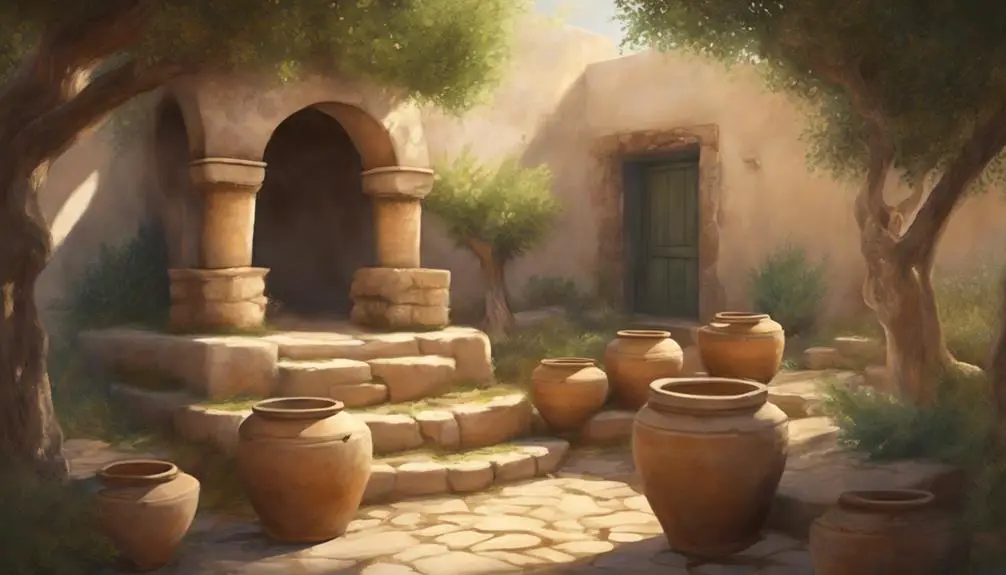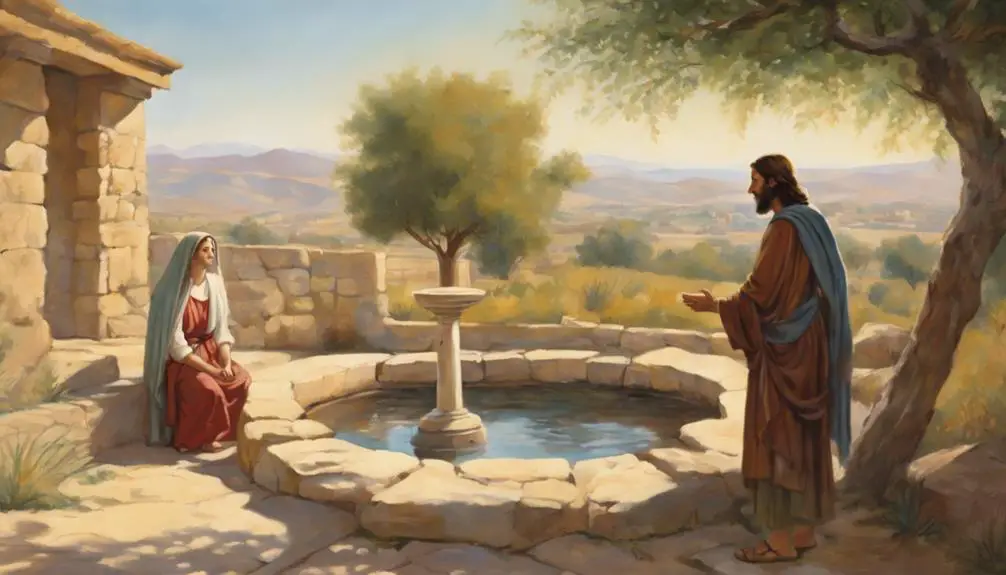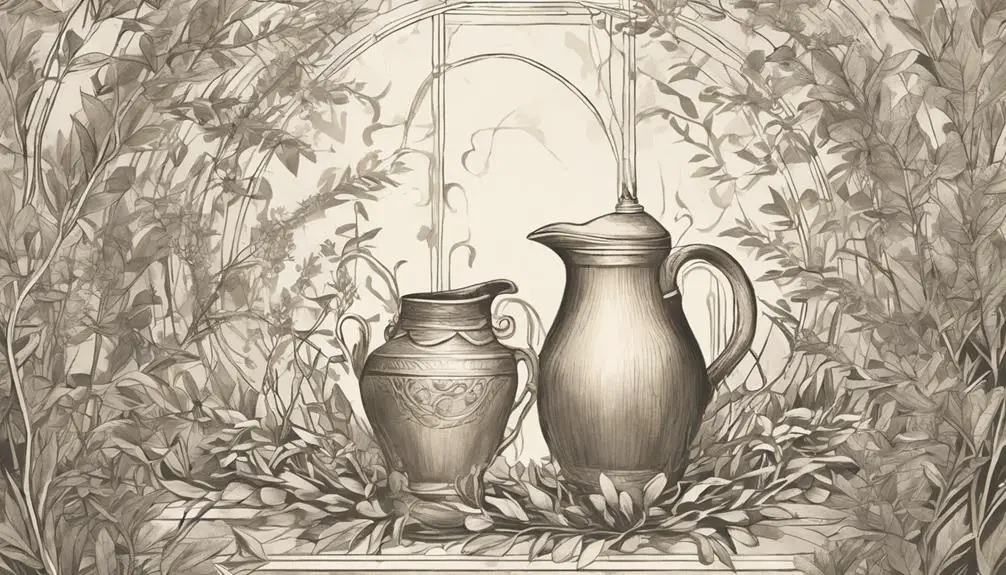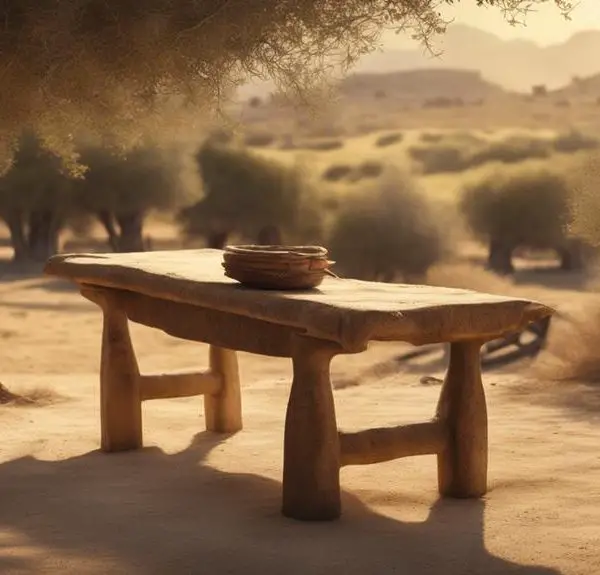Learn about Photine, the Samaritan woman whose encounter with Jesus at the well reveals transformative lessons on acceptance and breaking social barriers.

Photine in the Bible
Have you ever pondered the depths of a single encounter's power to transform a life? Consider the story of Photine, the Samaritan woman at the well, whose conversation with Jesus not only changed her but also offers profound insights into acceptance, redemption, and the breaking of social barriers.
As you explore her background, the symbolic meanings embedded in her narrative, and her impact on early Christianity, you'll uncover layers of significance that may challenge your understanding of familiar biblical stories. This journey promises to illuminate the legacy of Photine in a way that invites further contemplation on her role and relevance in today's world.
Key Takeaways
- Photine's encounter with Jesus at the well challenges societal norms and gender roles.
- Her story symbolizes spiritual cleansing and redemption, with water serving as a key motif.
- Photine undergoes a transformation, becoming a fervent evangelist and a symbol of faith and empowerment.
- She is recognized and venerated as a saint, enriching Christian theology with themes of forgiveness and divine dialogue.
The Encounter at the Well

Analyzing the encounter at the well, we observe a pivotal moment that not only reveals societal norms but also challenges them, marking a significant turning point in the narrative. The well serves as a multifaceted symbol, steeped in water significance, which is crucial for life and purification in many cultures. This setting isn't chosen at random but is integral to understanding the layers of meaning in the encounter.
Cultural norms of the time dictated strict gender roles and social interactions, particularly between men and women who weren't related. The well, a communal gathering place for water, becomes a stage for these norms to be both displayed and contested. The dialogue that ensues transcends mere conversation over water, delving into deeper spiritual and societal implications.
You'll notice that the interaction doesn't just challenge the norms but also subtly subverts them, creating a space where new understandings and revelations are possible. This exchange at the well, therefore, isn't merely about the physical act of drawing water but becomes a conduit for transformation, challenging both participants and observers to reconsider their preconceived notions and cultural constraints, inviting a reevaluation of societal constructs surrounding purity, identity, and community.
Photine's Background and Context
Understanding the encounter at the well lays a foundation for exploring Photine's background and context, shedding light on her role and significance within the narrative. Delving into her story requires an appreciation of the cultural settings and historical accuracy surrounding this biblical figure. You're venturing into a time deeply rooted in traditions and societal norms that shaped interactions and perceptions.
Photine's encounter, occurring in a period marked by rigid social divisions, reveals much about the cultural dynamics of her time. The act of speaking publicly with Jesus, a man not from her community, breaks conventional boundaries, highlighting her as a figure of both intrigue and courage. It's essential to grasp the significance of this interaction within its historical context to fully appreciate the narrative's depth.
The historical accuracy of Photine's story, while debated among scholars, provides a compelling glimpse into the lives of individuals during this era. You're examining a narrative that not only offers insights into Photine's personal journey but also reflects broader societal attitudes and changes.
Through this lens, Photine's background and context emerge as crucial elements for understanding her story, offering a rich tapestry of cultural and historical nuances that define her role within the biblical text.
Symbolic Interpretations of the Story

Delving into the symbolic interpretations of Photine's story, you'll uncover layers of meaning that extend beyond the literal narrative, offering insights into deeper spiritual and societal themes. The interplay between the literal and the metaphorical in Photine's encounter with Jesus at the well is rich with significance, revealing the nuanced ways in which cultural influences and artistic representations have shaped our understanding of this biblical episode.
Aspect |
Interpretation |
Relevance |
|---|---|---|
Water |
Symbol of life and spiritual cleansing |
Highlights the transformative power of spiritual knowledge. |
Well |
Meeting place, crossing of paths |
Represents the convergence of different lives and stories, emphasizing inclusivity. |
Noon |
Time of encounter |
Symbolizes a moment of enlightenment, the peak of spiritual clarity. |
Photine's past |
Her personal history |
Illustrates the theme of redemption and the universality of grace. |
Conversation |
Dialogue between Jesus and Photine |
Demonstrates the breaking of social and cultural barriers, emphasizing direct personal engagement with the divine. |
Through an analytical examination, it's evident that Photine's story is a canvas for cultural and theological reflection, where artistic representations have further enriched the narrative's layers, bridging ancient text and contemporary interpretation.
Photine's Transformation and Impact
Photine's encounter with Jesus at the well marks a profound transformation, significantly impacting her life and the early Christian community. This moment isn't just historical; it's a narrative that has echoed through time, finding relevance in diverse contexts. The story of Photine reflects a profound journey of faith, redemption, and empowerment, offering insights into the dynamics of cultural adaptations and modern parallels in how stories from ancient texts resonate today.
- Her transformation from a Samaritan woman with a complex personal history to a pivotal figure in Christian narratives showcases the power of personal change.
- The dialogue at the well serves as a metaphor for breaking barriers, emphasizing inclusivity and understanding.
- Photine's bold proclamation of her encounter with Jesus highlights the role of testimony in faith communities.
- Her story has inspired countless cultural adaptations, illustrating the timeless nature of her encounter.
- Modern parallels can be drawn in the way contemporary society seeks understanding and connection across different cultures and beliefs.
Analyzing Photine's transformation and impact sheds light on the enduring significance of her story. It's a testament to the ability of narrative to bridge time, culture, and belief, underscoring the universal quest for meaning, acceptance, and transformation.
Legacy of Photine in Christianity

Exploring the legacy of Photine in Christianity reveals how her story has significantly influenced theological discourse and devotional practices over the centuries. Recognized for her profound encounter with Jesus at the well, Photine's transformation from a Samaritan woman with a troubled past to a fervent evangelist provides a compelling narrative of redemption and spiritual awakening. Her recognition as a saint in various Christian traditions underscores her importance in the faith's history, highlighting her role as a model of faith and evangelism.
Photine's sainthood serves as a testament to her enduring impact on Christian thought and spirituality. The veneration she receives, especially within the Eastern Orthodox Church, illustrates the deep respect for her life's work and her example of unwavering faith in the face of adversity. Modern reflections on Photine's story have further enriched Christian theology, offering fresh insights into themes of forgiveness, societal judgment, and the transformative power of dialogue with the divine. These reflections encourage believers to re-examine their own lives in light of Photine's example, fostering a deeper understanding and appreciation of her legacy within the Christian tradition.
Frequently Asked Questions
What Are the Various Names and Titles Attributed to Photine Outside the Canonical Bible, and How Do They Differ Across Christian Traditions?
You're exploring how different Christian traditions have named and titled Photine, reflecting her origins and cultural variations. These names vary widely, from the Samaritan Woman to Saint Photine, highlighting her significance across communities. This divergence in titles underlines the rich tapestry of interpretations and the depth of her impact.
Analyzing these variations offers insight into the broader Christian narrative, illustrating how cultural contexts shape religious figures' identities and understandings.
How Has Photine Been Represented in Christian Art Throughout History, and What Symbols Are Commonly Associated With Her?
In Christian art, you'll find her depicted in various artistic mediums, each telling her story through powerful imagery and color symbolism.
Icons often portray her with a water jug, symbolizing her encounter at the well, while frescoes might capture her martyrdom with rich hues, indicating her spiritual significance.
The colors and symbols vary, but her representation across traditions underscores her revered status, blending historical reverence with theological insights.
What Specific Prayers, Hymns, or Liturgical Practices Have Been Developed in Honor of Photine Within Different Christian Denominations?
In exploring the reverence for Photine, you'll find various Christian denominations have developed specific prayers, hymns, and liturgical practices in her honor. This veneration is deeply influenced by Photine iconography and Samaritan traditions, reflecting an enduring legacy. Analyzing these expressions, it's evident how they encapsulate Photine's significance, blending historical reverence with contemporary worship.
The integration of these elements demonstrates a multifaceted approach to honoring her memory within the Christian faith.
Can You Provide Insights Into the Archaeological Discoveries or Historical Findings That May Corroborate the Existence or the Story of Photine?
Digging into history's layered sands, you'll find the quest for Photine's lineage and geographic origins a captivating tale.
While concrete evidence directly linking to her remains elusive, scholars analyze ancient texts and archaeological sites for clues. These efforts aim to piece together her story from the mosaic of early Christian movements.
This scholarly journey, though speculative, enriches our understanding of the broader historical context in which such figures are situated.
How Has the Story of Photine Influenced Modern Christian Thought, Particularly in Relation to Discussions on Women's Roles Within the Church and Society?
You've likely noticed that discussions on women's roles in the church and society often reference stories that highlight gender equality, including evangelical perspectives. These narratives deeply influence modern Christian thought, pushing for a reevaluation of traditional roles.
Conclusion
In examining Photine's narrative, you've ventured from the well's edge, where initial encounter blooms, into the depths of her background, unraveling layers of symbolism that pervade her story.
You've witnessed her transformation, understanding its ripple across Christianity's vast sea. Through scholarly lens, you've seen Photine not just as a figure, but as a testament to faith's power, challenging norms and inspiring generations.
Thus, her legacy endures, a beacon of change, reflection, and profound impact in the tapestry of Christian discourse.



Sign up